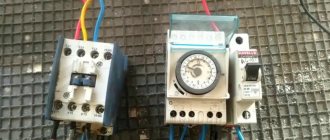What is technological connection
The term technological connection hides a service of a network organization, which implies ensuring the possibility of consuming electricity, that is, the actual connection of the consumer’s power receiving devices to their networks. This may sound a little complicated, but it will become clear now.
Imagine that you have purchased a plot to build a house. Everything would be fine, but there is one caveat. It is not connected to the general electrical network, or “to the poles,” as people say. Connecting your home “to the pole” is actually called technological connection.
Technological connection can be different, depending on the power of the energy receiving devices of the connected object. Some objects require a large amount of electricity, while our above-mentioned house requires relatively little - to keep it light, warm, and have electrical appliances working. Therefore, connection capacities are distinguished: up to 15 kW, from 15 to 150 kW, from 150 to 670 kW, and also over 670 kW. It is clear that the network applies its own requirements and tariffs to different categories of applicants. In addition, a consumer can be either an individual or a legal entity, which also implies its own nuances. In this article we are talking about us, average citizens - individuals with a power consumption of up to 15 kW.
Carrying out installation work
Installation work is carried out after the technical specifications have been prepared and all equipment has been purchased. You will also need an electrician who has the necessary experience and skills.
In addition, you should take into account the features of the project and not move away from the concept. If inconsistencies are visible, overvoltage may occur. This often leads to fire.
Important! After installation work, the inspector is obliged to check whether the work was completed successfully and whether it corresponds to the accepted project. If everything is done correctly, then permission to operate electrical networks is given.
You should also remember that the site must be visited by the employee who seals the equipment. The seals must remain intact. The employee records the initial indicators and passes them on to the owner for signature.
Submitting an individual's application for technical connection
The first thing we think about is what to do and where to go. And you may not even need to go anywhere. Our task now is to submit an application for technological connection to a network organization, and this can be done electronically. Now every network is required by law to have a personal account for technical connection on its website, so why not take advantage of it?
However, not always and not everywhere everything goes smoothly, so it is useful to know that an individual can also submit an application for technical connection in person or by mail. Here it is important to know the following: the application must be sent to the network organization whose energy facilities are located closest to your site. That is, whose “pillars” stand near our house (even if there is no house yet), we turn to that network.
But what should you do if there are facilities of several network organizations around you? The question is far from idle, since this sometimes occurs even in small villages, often causing confusion in the orderly way of life of their residents. In this case, we can choose any network, provided that its objects are located within 300 meters from the boundaries of our site.
You must submit an application using a special form - an application form for an individual to connect to one source of power supply to power receiving devices with a maximum power of up to 15 kW inclusive. Filling out this paper can sometimes be challenging, so we've covered it in detail here.
Further interaction between the applicant and the network organization, according to current legislation, is carried out only through a personal account on the website of this network organization. After submitting an application, the network considers it within 3 days, and if any documents or information are missing, it must notify about this with the appropriate Notification. These materials must be provided within 20 working days, otherwise the application will be cancelled. If everything is in order with the documents, then the network organization is obliged to post the following documents in your personal account within 10 working days:
- Terms of a standard TP agreement.
- Technical specifications with a list of TP activities.
- Instructions with a list of measures for safe actual connection and consumption for the applicant.
- Account for payment of payment for TP.
After posting the documents, we have to pay the invoice within 5 working days, which in fact will mean concluding an agreement with the network organization. A classic agreement on paper does not need to be concluded either in person or in absentia, since such a procedure is not provided for by law. Within one business day after receiving information about payment of the invoice, the network is obliged to notify us about this.
Connecting electricity to SNT
To answer the questions, the following documents and regulations were used:
- Federal Law of April 15, 1998 No. 66-FZ “On horticultural, market gardening and dacha non-profit associations of citizens”;
- Federal Law No. 217-FZ dated July 29, 2017 “On gardening and vegetable gardening by citizens for their own needs and on amendments to certain legislative acts of the Russian Federation”;
- Federal Law of March 26, 2003 No. 35-FZ “On Electric Power Industry”;
- Federal Law of July 27, 2006 N 152-FZ “On Personal Data”;
- Basic provisions for the functioning of retail electricity markets (approved by Decree of the Government of the Russian Federation dated May 4, 2012 No. 442);
- Rules for the technological connection of power receiving devices of electrical energy consumers, electrical energy production facilities, as well as electrical grid facilities belonging to network organizations and other persons to electrical networks (approved by Decree of the Government of the Russian Federation dated December 27, 2004 No. 861);
- Draft resolution of the Government of the Russian Federation “On amendments to the Rules for the technological connection of power receiving devices of electrical energy consumers, electrical energy production facilities, as well as power grid facilities belonging to network organizations and other persons, to electric networks on the issue of technological connection of power receiving devices belonging to citizens, those carrying out gardening or vegetable farming on land plots located within the boundaries of the gardening or vegetable farming territory, and other rights holders of real estate located within the boundaries of the gardening or vegetable farming territory";
- Appeal ruling of the Moscow Regional Court dated June 28, 2019 in case No. 33-28279/2019;
- Appeal ruling of the Moscow Regional Court dated 04/04/2019 in case No. 33-14184/2019;
- Decision of the Arbitration Court of the Moscow Region dated November 11, 2019 in case No. A41-55343/2019;
- Decision of the Moscow Arbitration Court dated 03/06/2019 in case No. A40-229365/18.
Based on the information provided, I report the following:
The gardener is already connected to SNT networks and is satisfied with the allocated power
According to clause 32 of the Basic Provisions for the Functioning of Retail Electricity Markets (approved by Decree of the Government of the Russian Federation dated May 4, 2012 No. 442), the supplier of last resort is obliged to enter into an energy supply agreement with any consumer who contacts him, whose power receiving devices are located in the area of activity of the supplier of last resort and in the prescribed manner connected to electric grid facilities or in relation to the power receiving devices of which an agreement has been concluded on the implementation of technological connection to the electric networks of the network organization.
According to clause 34 of the Basic Provisions, a citizen carrying out gardening on the territory of SNT, in order to conclude a direct contract, provides any documents confirming the presence of a technological connection to the power grid facilities of SNT.
Therefore, if the owner of the site is already connected to the SNT networks (which is confirmed, for example, by the act of delimiting balance sheet ownership), then he can freely enter into a power supply agreement directly with the guaranteeing supplier. The power allocated to the citizen will be established on the basis of SNT documents on the allocation of power.
In other cases, the gardener needs to obtain a technological connection act.
The gardener is not connected to SNT networks or is connected but wants to increase the allocated power. What if the owner of the networks is another person?
According to paragraphs 2 - 2(2) of the Rules for the technological connection of power receiving devices of electrical energy consumers, electrical energy production facilities, as well as electrical grid facilities belonging to network organizations and other persons, to electrical networks (approved by Decree of the Government of the Russian Federation dated December 27, 2004 No. 861, hereinafter referred to as “Rules No. 861”), the effect of these Rules applies to cases of connection of power receiving devices and electric power facilities that:
- put into operation for the first time;
- put into operation after a period of conservation;
- have already been put into operation, but it is necessary to change the permitted maximum power or reliability category of the device.
All these cases are options for technological connection.
Clause 8(5) of Rules No. 861 establishes that the technological connection of power receiving devices located on the territory of SNT and owned by individuals (garden houses, residential buildings, outbuildings) is carried out on the basis of an application from SNT to the network organization, and SNT does not have the right to refuse to submit to network organization of such an application, hinder such connection and demand payment for it.
The prohibition of SNT to interfere with the use of its networks corresponds to the provisions of both the current law on horticulture No. 217-FZ and the previously in force Law No. 66-FZ, according to which public property is created, acquired and maintained by SNT at the expense of contributions that are required to be paid as members of SNT , so individuals who garden individually. All gardeners have the right to use common property on equal terms.
The location of electric grid facilities in SNT is not owned, but on the basis of a lease or free use agreement does not affect the scope of rights and obligations of SNT. Rules No. 861 do not distinguish between an owner and another legal owner. SNT, owning networks under a contract, is the legal owner and can carry out all actions provided for by Rules No. 861. If the lease/free use agreement provides for a prohibition for SNT to submit applications for technological connection, this condition will contradict Rules No. 861 and may be declared invalid in court.
Until January 1, 2021, individual gardeners had the right to submit an application for technological connection independently. In this case, the network organization itself would resolve all issues with SNT and, if necessary, would require the approval of technical conditions and the absence of obstacles to connecting the citizen’s power receiving devices to SNT’s electrical networks (decision of the Arbitration Court of the Moscow Region dated November 11, 2019 in case No. A41-55343/ 2019). Currently, the application must be sent by SNT.
Thus, if a person contacts SNT, whose site is located on the territory of SNT and is not connected to the electrical network, SNT is obliged to send an application for technological connection to the network organization.
If a gardener already connected to SNT networks wants to increase the power allocated to him, then SNT is also obliged to send a corresponding application to the network organization. The network organization, if technically possible, accordingly increases the power that can be supplied to the SNT networks through which this gardener is connected.
In this case, the following must be taken into account: according to sub. “z” clause 10 of Rules No. 861, an SNT application to a network organization must be accompanied by a certificate of the number of land plots located within the boundaries of the horticulture or truck farming territory, indicating information about the last name, first name, patronymic of the owners of the land plots, series, numbers and dates of issue passports or other identification documents in accordance with the legislation of the Russian Federation.
In addition, SNT does not have the right to transfer personal data of plot owners (full name, series and passport numbers) to the network organization without the written consent of the owners (Article 9 of Federal Law No. 152-FZ “On Personal Data”).
Thus, SNT in most cases is deprived of the opportunity to submit an application for technological connection that meets the requirements of Rule No. 861.
Since information about the passport data of plot owners in SNT is often missing and cannot be obtained or transferred to the network organization, the latter will most likely refuse to carry out technological connection. The courts recognize such a refusal as legal (decision of the Moscow Arbitration Court dated March 6, 2019 in case No. A40-229365/18).
Currently (April 2021), a draft resolution of the Government of the Russian Federation is being prepared to amend Rules No. 861, which eliminates all the features of connecting power receiving devices located on the territory of SNT. If these changes are adopted, the owners of facilities on the territory of SNT will be able to submit an application for technological connection to the network organization in the general manner without the participation of SNT. A certificate with passport details of all owners will also not be needed.
However, if, when contacting a network organization, a citizen hides the fact of an existing connection and, on this basis, formalizes a new technological connection and concludes an energy supply agreement with the guaranteeing supplier, then both the agreement on technological connection and the energy supply agreement may be declared invalid by the court at the claim of SNT on on the basis of clause 1 of Art. 26 of Federal Law No. 35-FZ dated March 26, 2003 “On Electric Power Industry” (appeal rulings of the Moscow Regional Court dated June 28, 2019 in case No. 33-28279/2019 and dated April 4, 2019 in case No. 33-14184/2019).
It is worth noting that if all the power possible for the existing SNT networks has already been distributed among gardeners by decision of the general meeting of SNT members, and the connection of new capacities requires upgrading the networks, then according to subclause. “a” clause 28 of Rules No. 861 it is considered that the technical possibility of technological connection is absent. In this case, technological connection is carried out according to an individual project, the implementation of which can only be carried out on the basis of a decision of the general meeting of SNT members, since issues of creation, reconstruction, and the procedure for using common property fall within the exclusive competence of SNT. If the network facilities are not owned by SNT, then the owner of the networks must also agree to modernize their networks.
There are no problems with concluding a direct contract with a supplier of last resort only for a gardener who is already connected to SNT networks and does not intend to change the power allocated to him.
Summary
A gardener who is not connected to SNT networks has the right to demand that SNT send an application for its technological connection to the network organization. If there is a technical possibility for technological connection, the gardener will be connected, and he will be able to enter into a direct contract with the guaranteeing supplier.
A gardener who is already connected to SNT networks and wants to increase the power allocated to him also has the right to demand that SNT send a corresponding application to the network organization. After completing the technological connection act, he will also be able to enter into a direct agreement with the supplier of last resort.
In both cases, SNT must send an application to the network organization. However, it is very likely that SNT, due to objective reasons, will not be able to attach all the necessary documents to the application, and therefore the network organization will refuse to conclude an agreement on technological connection to electric networks and further conclusion of a direct agreement will become impossible.
A gardener already connected to SNT networks can easily enter into a direct contract with a supplier of last resort within the limits of the capacity previously allocated to him by SNT. SNT participation in this process is not required.
The most effective protection of the interests of the network owner (prohibition of connection without his consent) is:
- adoption by the general meeting of SNT members of a decision on the distribution of power provided by SNT in favor of already connected persons, and the power unused by connected gardeners must be transferred to the owner of the networks. In this case, it will be able to subsequently conclude agreements with those who wish to redistribute its power. It will work if SNT networks are not capable of accepting additional load;
- termination of the lease agreement (free use) of networks concluded with SNT and the conclusion of a new energy supply agreement in the name of the owner of the networks. In this case, SNT will cease to be the owner of the networks, and the networks will cease to be the public property of SNT. Already connected gardeners will retain their power, and new connections to the owner’s networks (including an increase in power) will only be possible with the consent of the owner of the networks. After the seizure of electric grid facilities from SNT, the responsibility for their maintenance will fall on the owner.
Helpful advice? Share on social networks!
Need legal help? Call
Time frame for technological connection
The law provides for certain deadlines for carrying out technological connection measures:
- up to 4 months from the date of payment of the invoice, if “the network organization does not need to carry out work on the construction (reconstruction) of the existing electrical network, with the exception of work on the construction of electrical grid facilities from existing electrical grid facilities to connected power receiving devices”;
- up to 6 months if such construction or reconstruction is required.
However, usually technological connection is carried out earlier than the specified deadlines. What should we do if for some reason we need to connect to networks in a shorter time? This possibility exists. To do this, you can submit an application for temporary technological connection, which is completed within up to 15 days. However, it should be remembered that temporary connection is possible only if it is technically possible and you will have to pay for the technological connection its full cost.
What is the preparation time frame on the part of the applicant? For your part, you need to prepare for technical connection within the boundaries of your balance sheet. There is still information that the network checks power-receiving equipment, that is, checking the applicant’s compliance with technical conditions. In fact, now, according to network law, it is completely indifferent what happens after the “counter”. In fact, by installing the meter and applying voltage to it, the network organization fulfilled its obligations. When and how the applicant connects to the output terminals and turns on the machine is not important from the point of view of the law. For a secure connection, there are instructions in your personal account. In fact, network companies usually do not take risks and carry out the connection on the part of the applicant on their own. Although they are not required to do this.
What then
After the permit and technical conditions have been received, it is necessary to develop a project for the electrification of the site. In principle, you can draw up a plan for wiring around the house yourself, but if the house is large, with utility and technical rooms, with electricity output to the area where the pumping station or water supply pump is installed, it is better to order the project from a specialized organization. And the best option is in the energy sales organization where you applied for connection. There will be much fewer problems with acceptance.
Example of a home electrification project
If you draw up the project yourself, it will need to be approved by the energy supply organization. If the requirements are met, they will approve it for you; if there are violations, they will indicate what needs to be changed. After making changes, you submit the project again for signature. Only having a completed signed project in hand can you begin to implement it.
What to do after completing the technological connection?
After the network organization fulfills its part of the technical conditions, it draws up an act on the implementation of technological connection, which is posted in the applicant’s personal account on its website. The certificate of approval for operation of the metering device is also placed here, which the network carries out independently without anyone’s participation. The network notifies the guaranteeing supplier about the preparation of the above-mentioned acts, the applicant’s contract with whom begins to be valid from the day the documents are posted in the personal account. Well, that’s all, actually. No further documents are required.
Despite its apparent simplicity, people continue to encounter difficulties when connecting to electrical networks. Therefore, I recorded a detailed course where I talk about all the nuances of the technological connection procedure for individuals up to 15 kW. Go ahead and take a look. Let me remind you that the first lesson is completely free and, after watching it, you will be able to understand whether this course is right for you, the cost of which is quite symbolic compared to the information that you will receive.
Watch the first lesson for free
Specifications
Obtaining technical specifications is not as difficult as it looks from the outside. The organization must issue them no later than two weeks. Such a time frame is given for consideration of the application.
The received documentation indicates:
- voltage level;
- insertion point;
- highest level of network load.
After receiving these conditions, you can legally supply electricity to the site. This documentary permission serves as the basis for creating the project.
Remember! Specifications must demonstrate the capacity of the equipment that will be used at the site in the future. Employees need to multiply this figure by the simultaneous inclusion factor, which is 0.6.
You can submit your application online. In addition, this can be done in writing. The application should indicate whether the applicant intends to use electricity for heating in the future, and what type of network is planned to be used - single-phase or three-phase.
To supply electricity to private houses or summer cottages in the capital region, the fact that the voltage in the network will be important is:
- 380 Volt;
- 220 volt.
All required documentation is submitted simultaneously with the application, in particular those that can confirm rights to a plot of land.
It is worth remembering that if any communications exist, you should report this.
As a rule, the connection of electrical networks is carried out as part of preparing the site for construction work.
Pressure levers
Some may encounter difficulties, for example, the organization connecting electricity did not issue an agreement for TP and technical specifications, or did not meet the deadline allotted by law.
In order to defend yourself, you need to know:
- According to the standards of our time, the power plant is obliged to lay the electric line no further than 25 meters from the applicant’s site.
- The procedure for connecting to the networks of a network organization is regulated by the Rules for the technological connection of power receiving devices. This is prescribed by the Government of the Russian Federation. Resolution No. 861 of December 27, 2004;
- Since electric grid organizations are monopolies, they have legal protection from competitors.
- These companies are regulated. If they deviate from legal obligations, the company may be fined.
Connection. Stages
Submitting an application for connection to the nearest electric company.- Receiving and familiarizing yourself with documentation and specifications from the power grid organization.
- Conclusion of an agreement.
- Carrying out work on both sides as specified in the technical specifications. The customer is on his site, the organization is outside.
- Electricity is connected and voltage is supplied to energy-consuming devices.
- Signing the contract.
This is a common scheme, because most often the connection to the power supply occurs this way. But there are certain nuances that you definitely need to know before you start collecting documents.
First, you should find out about the availability of an electrical network nearby, with the power you need, and also find out the distance from the house to them. This point is worth focusing on. After all, it is this distance that is the decisive factor for setting the timing and prices for connecting electricity.
You have the right to request network location information. This service is provided absolutely free of charge.
Electrification of the house - ideal and real conditions
There are no, and cannot be, uniform rules for bringing electricity into a house. Each city, town or region of residence has its own. They depend on various factors, therefore, for consumers, such rules are determined by the electric grid company whose services you will use and whose capacities you will connect to. Separate rules apply for approving changes in electricity consumption in apartments in multi-apartment buildings. Therefore, to get acquainted with the general algorithm of actions, we will assume that the house that needs to be provided with electricity is located within the city and there is already a ready-made power line on the street that needs to be connected to.
In this case, you can be guided by the rules that are defined in the Decree of the Government of the Russian Federation “On amendments to certain acts of the Government of the Russian Federation on improving the procedure for technological consumers to electric networks” dated April 21, 2009. This document determines that if the distance to the nearest power line support from the connection point in a straight line does not exceed twenty-five meters, then to connect the house you do not even need to install an additional power line support. However, before equipping a branch, it is necessary to obtain technical specifications from the electrical company. In addition, you need to remember that in simple cases the cost of creating a new connection point cannot be more than 550 rubles.











